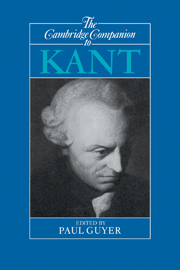Book contents
- Frontmatter
- Introduction
- 1 Kant's intellectual development
- 2 The Transcendental Aesthetic
- 3 Functions of thought and the synthesis of intuitions
- 4 The transcendental deduction of the categories
- 5 Causal laws and the foundations of natural science
- 6 Empirical, rational, and transcendental psychology
- 7 Reason and the practice of science
- 8 The critique of metaphysics
- 9 Vindicating reason
- 10 Autonomy, obligation, and virtue
- 11 Politics, freedom, and order
- 12 Taste, sublimity, and genius
- 13 Rational theology, moral faith, and religion
- 14 The first twenty years of critique
- Bibliography
- Index
12 - Taste, sublimity, and genius
The aesthetics of nature and art
Published online by Cambridge University Press: 28 May 2006
- Frontmatter
- Introduction
- 1 Kant's intellectual development
- 2 The Transcendental Aesthetic
- 3 Functions of thought and the synthesis of intuitions
- 4 The transcendental deduction of the categories
- 5 Causal laws and the foundations of natural science
- 6 Empirical, rational, and transcendental psychology
- 7 Reason and the practice of science
- 8 The critique of metaphysics
- 9 Vindicating reason
- 10 Autonomy, obligation, and virtue
- 11 Politics, freedom, and order
- 12 Taste, sublimity, and genius
- 13 Rational theology, moral faith, and religion
- 14 The first twenty years of critique
- Bibliography
- Index
Summary
CRITIQUE OF JUDGMENT
With the Critique of Judgment (1790), Kant completed his critical enterprise. To this day, however, the third of his three Critiques has remained the darkest of Kant;s published works and the most inaccessible to the philosophical reader. Its two parts, the Critique of Aesthetic Judgment and the Critique of Teleological Judgment, are bracketed together by a formidable Introduction - two, in fact: one usually referred to as the First Introduction, and the shorter one Kant substituted for it for publication. Both introductions are relentlessly technical, both rehearse the Kantian scheme as a whole, drawing and redrawing well-known and new distinctions and contrasts; both address themselves to “philosophy as a system” They see the third Critique as a culmination and completion of critical philosophy, now enlarged in scope and thus requiring a number of retrospective adjustments to earlier projections of the architectonics of the entire edifice.
- Type
- Chapter
- Information
- The Cambridge Companion to Kant , pp. 367 - 393Publisher: Cambridge University PressPrint publication year: 1992
- 19
- Cited by

